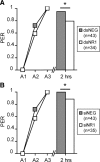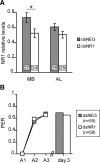Acute disruption of the NMDA receptor subunit NR1 in the honeybee brain selectively impairs memory formation
- PMID: 20534830
- PMCID: PMC6632693
- DOI: 10.1523/JNEUROSCI.5543-09.2010
Acute disruption of the NMDA receptor subunit NR1 in the honeybee brain selectively impairs memory formation
Abstract
Memory formation is a continuous process composed of multiple phases that can develop independently from each other. These phases depend on signaling pathways initiated after the activation of receptors in different brain regions. The NMDA receptor acts as a sensor of coincident activity between neural inputs, and, as such, its activation during learning is thought to be crucial for various forms of memory. In this study, we inhibited the expression of the NR1 subunit of the NMDA receptor in the honeybee brain using RNA interference. We show that the disruption of the subunit expression in the mushroom body region of the honeybee brain during and shortly after appetitive learning selectively impaired memory. Although the formation of mid-term memory and early long-term memory was impaired, late long-term memory was left intact. This indicates that late long-term memory formation differs in its dependence on NMDA receptor activity from earlier memory phases.
Figures







Comment in
-
What's the buzz about honeybee memory?J Neurosci. 2010 Nov 3;30(44):14593-4. doi: 10.1523/JNEUROSCI.3951-10.2010. J Neurosci. 2010. PMID: 21048116 Free PMC article. Review. No abstract available.
Similar articles
-
Specific requirement of NMDA receptors for long-term memory consolidation in Drosophila ellipsoid body.Nat Neurosci. 2007 Dec;10(12):1578-86. doi: 10.1038/nn2005. Epub 2007 Nov 4. Nat Neurosci. 2007. PMID: 17982450 Free PMC article.
-
Identification and localisation of the NR1 sub-unit homologue of the NMDA glutamate receptor in the honeybee brain.Neurosci Lett. 2006 May 8;398(3):274-9. doi: 10.1016/j.neulet.2006.01.007. Epub 2006 Feb 15. Neurosci Lett. 2006. PMID: 16480817
-
RNA interference-mediated gene silence of the NR1 subunit of the NMDA receptor by subcutaneous injection of vector-encoding short hairpin RNA reduces formalin-induced nociception in the rat.Pain. 2011 Mar;152(3):573-581. doi: 10.1016/j.pain.2010.11.026. Epub 2011 Jan 15. Pain. 2011. PMID: 21239115
-
Translational regulation of the N-methyl-D-aspartate receptor subunit NR1.Neurosignals. 2004 Jul-Aug;13(4):190-3. doi: 10.1159/000077525. Neurosignals. 2004. PMID: 15148447 Review.
-
Plasticity, hippocampal place cells, and cognitive maps.Arch Neurol. 2001 Jun;58(6):874-81. doi: 10.1001/archneur.58.6.874. Arch Neurol. 2001. PMID: 11405801 Review.
Cited by
-
Honey bee functional genomics using symbiont-mediated RNAi.Nat Protoc. 2023 Mar;18(3):902-928. doi: 10.1038/s41596-022-00778-4. Epub 2022 Dec 2. Nat Protoc. 2023. PMID: 36460809 Review.
-
In-vivo egfp expression in the honeybee Apis mellifera induced by electroporation and viral expression vector.PLoS One. 2022 Jun 2;17(6):e0263908. doi: 10.1371/journal.pone.0263908. eCollection 2022. PLoS One. 2022. PMID: 35653376 Free PMC article.
-
A proboscis extension response protocol for investigating behavioral plasticity in insects: application to basic, biomedical, and agricultural research.J Vis Exp. 2014 Sep 8;(91):e51057. doi: 10.3791/51057. J Vis Exp. 2014. PMID: 25225822 Free PMC article.
-
Pharmacologic inhibition of phospholipase C in the brain attenuates early memory formation in the honeybee (Apis mellifera L.).Biol Open. 2018 Jan 12;7(1):bio028191. doi: 10.1242/bio.028191. Biol Open. 2018. PMID: 29330349 Free PMC article.
-
Protein degradation by ubiquitin-proteasome system in formation and labilization of contextual conditioning memory.Learn Mem. 2014 Aug 18;21(9):478-87. doi: 10.1101/lm.035998.114. Print 2014 Sep. Learn Mem. 2014. PMID: 25135196 Free PMC article.
References
-
- Barbara GS, Zube C, Rybak J, Gauthier M, Grunewald B. Acetylcholine, GABA and glutamate induce ionic currents in cultured antennal lobe neurons of the honeybee, Apis mellifera. J Comp Physiol A Neuroethol Sens Neural Behav Physiol. 2005;191:823–836. - PubMed
-
- Bitterman ME, Menzel R, Fietz A, Schafer S. Classical conditioning of proboscis extension in honeybees (Apis mellifera) J Comp Psychol. 1983;97:107–119. - PubMed
-
- Breer H, Sattelle DB. Molecular properties and functions of insect acetylcholine receptors. J Insect Physiol. 1987;33:771–790.
-
- Casadio A, Martin KC, Giustetto M, Zhu H, Chen M, Bartsch D, Bailey CH, Kandel ER. A transient, neuron-wide form of CREB-mediated long-term facilitation can be stabilized at specific synapses by local protein synthesis. Cell. 1999;99:221–237. - PubMed
Publication types
MeSH terms
Substances
LinkOut - more resources
Full Text Sources
Other Literature Sources
Medical
